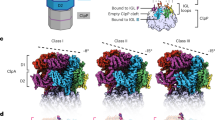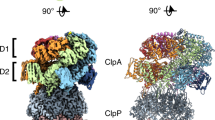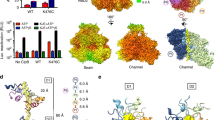Abstract
Adaptor proteins modify substrate recognition by AAA+ ATPases. We examined how the adaptor ClpS regulates substrate choice by the Escherichia coli protease ClpAP. Binding of six ClpS molecules to a ClpA hexamer enhanced N-end-rule substrate degradation and inhibited ssrA-tagged protein proteolysis. Substoichiometric ClpS binding allowed intermediate degradation of both substrate types, revealing that adaptor stoichiometry influences substrate choice. ClpS controls substrate selection using distinct mechanisms. The N-terminal segment is essential for delivering N-end-rule substrates but dispensable for ssrA-protein inhibition. We tested existing models for ClpS action and found that ClpS does not block recognition of ssrA-tagged substrates by steric occlusion and that adaptor-mediated tethering of N-end-rule substrates to ClpAP was insufficient to explain facilitated delivery. We propose that ClpS functions, at least in part, as an allosteric effector of ClpAP, broadening our understanding of how AAA+ adaptors control substrate selection.
This is a preview of subscription content, access via your institution
Access options
Subscribe to this journal
Receive 12 print issues and online access
$189.00 per year
only $15.75 per issue
Buy this article
- Purchase on Springer Link
- Instant access to full article PDF
Prices may be subject to local taxes which are calculated during checkout






Similar content being viewed by others
Accession codes
References
Neuwald, A.F., Aravind, L., Spouge, J.L. & Koonin, E.V. AAA+: a class of chaperone-like ATPases associated with the assembly, operation, and disassembly of protein complexes. Genome Res. 9, 27–43 (1999).
Vale, R.D. AAA proteins. Lords of the ring. J. Cell Biol. 150, F13–F19 (2000).
Hanson, P.I. & Whiteheart, S.W. AAA+ proteins: have engine, will work. Nat. Rev. Mol. Cell Biol. 6, 519–529 (2005).
Mogk, A. et al. Broad yet high substrate specificity: the challenge of AAA+ proteins. J. Struct. Biol. 146, 90–98 (2004).
Baker, T.A. & Sauer, R.T. ATP-dependent proteases of bacteria: recognition logic and operating principles. Trends Biochem. Sci. 31, 647–653 (2006).
Katayama, Y. et al. The two-component, ATP-dependent Clp protease of Escherichia coli. Purification, cloning, and mutational analysis of the ATP-binding component. J. Biol. Chem. 263, 15226–15236 (1988).
Woo, K.M., Chung, W.J., Ha, D.B., Goldberg, A.L. & Chung, C.H. Protease Ti from Escherichia coli requires ATP hydrolysis for protein breakdown but not for hydrolysis of small peptides. J. Biol. Chem. 264, 2088–2091 (1989).
Beuron, F. et al. At sixes and sevens: characterization of the symmetry mismatch of the ClpAP chaperone-assisted protease. J. Struct. Biol. 123, 248–259 (1998).
Weber-Ban, E.U., Reid, B.G., Miranker, A.D. & Horwich, A.L. Global unfolding of a substrate protein by the Hsp100 chaperone ClpA. Nature 401, 90–93 (1999).
Keiler, K.C., Waller, P.R. & Sauer, R.T. Role of a peptide tagging system in degradation of proteins synthesized from damaged messenger RNA. Science 271, 990–993 (1996).
Gottesman, S., Roche, E., Zhou, Y. & Sauer, R.T. The ClpXP and ClpAP proteases degrade proteins with carboxy-terminal peptide tails added by the SsrA-tagging system. Genes Dev. 12, 1338–1347 (1998).
Dougan, D.A., Reid, B.G., Horwich, A.L. & Bukau, B. ClpS, a substrate modulator of the ClpAP machine. Mol. Cell 9, 673–683 (2002).
Guo, F., Esser, L., Singh, S.K., Maurizi, M.R. & Xia, D. Crystal structure of the heterodimeric complex of the adaptor, ClpS, with the N-domain of the AAA+ chaperone, ClpA. J. Biol. Chem. 277, 46753–46762 (2002).
Zeth, K. et al. Structural analysis of the adaptor protein ClpS in complex with the N-terminal domain of ClpA. Nat. Struct. Biol. 9, 906–911 (2002).
Erbse, A. et al. ClpS is an essential component of the N-end rule pathway in Escherichia coli. Nature 439, 753–756 (2006).
Wang, K.H., Sauer, R.T. & Baker, T.A. ClpS modulates but is not essential for bacterial N-end rule degradation. Genes Dev. 21, 403–408 (2007).
Tobias, J.W., Shrader, T.E., Rocap, G. & Varshavsky, A. The N-end rule in bacteria. Science 254, 1374–1377 (1991).
Xia, D., Esser, L., Singh, S.K., Guo, F. & Maurizi, M.R. Crystallographic investigation of peptide binding sites in the N-domain of the ClpA chaperone. J. Struct. Biol. 146, 166–179 (2004).
Farrell, C.M., Grossman, A.D. & Sauer, R.T. Cytoplasmic degradation of ssrA-tagged proteins. Mol. Microbiol. 57, 1750–1761 (2005).
Flynn, J.M. et al. Overlapping recognition determinants within the ssrA degradation tag allow modulation of proteolysis. Proc. Natl. Acad. Sci. USA 98, 10584–10589 (2001).
Hirel, P.H., Schmitter, M.J., Dessen, P., Fayat, G. & Blanquet, S. Extent of N-terminal methionine excision from Escherichia coli proteins is governed by the side-chain length of the penultimate amino acid. Proc. Natl. Acad. Sci. USA 86, 8247–8251 (1989).
Hinnerwisch, J., Reid, B.G., Fenton, W.A. & Horwich, A.L. Roles of the N-domains of the ClpA unfoldase in binding substrate proteins and in stable complex formation with the ClpP protease. J. Biol. Chem. 280, 40838–40844 (2005).
Piszczek, G., Rozycki, J., Singh, S.K., Ginsburg, A. & Maurizi, M.R. The molecular chaperone, ClpA, has a single high affinity peptide binding site per hexamer. J. Biol. Chem. 280, 12221–12230 (2005).
Hinnerwisch, J., Fenton, W.A., Furtak, K.J., Farr, G.W. & Horwich, A.L. Loops in the central channel of ClpA chaperone mediate protein binding, unfolding, and translocation. Cell 121, 1029–1041 (2005).
Levchenko, I., Seidel, M., Sauer, R.T. & Baker, T.A. A specificity-enhancing factor for the ClpXP degradation machine. Science 289, 2354–2356 (2000).
Wah, D.A. et al. Flexible linkers leash the substrate binding domain of SspB to a peptide module that stabilizes delivery complexes with the AAA+ ClpXP protease. Mol. Cell 12, 355–363 (2003).
Dougan, D.A., Weber-Ban, E. & Bukau, B. Targeted delivery of an ssrA-tagged substrate by the adaptor protein SspB to its cognate AAA+ protein ClpX. Mol. Cell 12, 373–380 (2003).
Bolon, D.N., Wah, D.A., Hersch, G.L., Baker, T.A. & Sauer, R.T. Bivalent tethering of SspB to ClpXP is required for efficient substrate delivery: a protein-design study. Mol. Cell 13, 443–449 (2004).
Wah, D.A., Levchenko, I., Baker, T.A. & Sauer, R.T. Characterization of a specificity factor for an AAA+ ATPase: assembly of SspB dimers with ssrA-tagged proteins and the ClpX hexamer. Chem. Biol. 9, 1237–1245 (2002).
Kirstein, J. et al. Adaptor protein controlled oligomerization activates the AAA+ protein ClpC. EMBO J. 25, 1481–1491 (2006).
Kim, Y.I., Burton, R.E., Burton, B.M., Sauer, R.T. & Baker, T.A. Dynamics of substrate denaturation and translocation by the ClpXP degradation machine. Mol. Cell 5, 639–648 (2000).
Kim, Y.I. et al. Molecular determinants of complex formation between Clp/Hsp100 ATPases and the ClpP peptidase. Nat. Struct. Biol. 8, 230–233 (2001).
Acknowledgements
We thank K. Wang (Massachusetts Institute of Technology) for generously providing N-end-rule proteins and P. Chien, M. Laub, T. Schwartz, K. Wang, C. Wu and members of the Baker and Sauer Labs for discussion and advice. Plasmid clpA M169T/pET9a was a gift from J. Flanagan (Hershey Medical Center). T.A.B. is an employee of the Howard Hughes Medical Institute. This work was supported by US National Institutes of Health grant GM49224 and the Howard Hughes Medical Institute.
Author information
Authors and Affiliations
Contributions
J.Y.H. carried out the experiments. J.Y.H., R.T.S. and T.A.B. contributed to experimental design and wrote the manuscript.
Corresponding author
Supplementary information
Supplementary Text and Figures
Supplementary Figures 1–2, Supplementary Methods (PDF 214 kb)
Rights and permissions
About this article
Cite this article
Hou, J., Sauer, R. & Baker, T. Distinct structural elements of the adaptor ClpS are required for regulating degradation by ClpAP. Nat Struct Mol Biol 15, 288–294 (2008). https://doi.org/10.1038/nsmb.1392
Received:
Accepted:
Published:
Issue Date:
DOI: https://doi.org/10.1038/nsmb.1392
This article is cited by
-
An optogenetic toolbox of LOV-based photosensitizers for light-driven killing of bacteria
Scientific Reports (2018)
-
Adapting the machine: adaptor proteins for Hsp100/Clp and AAA+ proteases
Nature Reviews Microbiology (2009)
-
Structural basis of N‐end rule substrate recognition in Escherichia coli by the ClpAP adaptor protein ClpS
EMBO reports (2009)
-
The N-end rule at atomic resolution
Nature Structural & Molecular Biology (2008)



